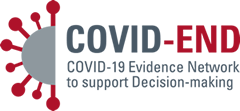Tips and tools
The COVID-19 pandemic requires decision-makers to have timely access to the highest-quality research evidence in language that they understand. COVID-END has prepared tips for individuals and groups seeking to use the best available research evidence to support decision-making about COVID-19.
Two of the tips are about making sure you have the right team and relationships in place:
- If you are not already an individual or group working in close partnership with decision-makers, consider working with groups that have such partnerships
- If you are not already an individual or group with rich experience in finding, contextualizing, packaging and sharing research evidence for decision-makers, consider working with individuals and groups that have such experience
Six of the tips focus on creating the right processes to respond to requests from decision-makers, which ideally build on the lessons learned from those with rich experience in finding, contextualizing, packaging and sharing research evidence for decision-makers while adapting these lessons learned to the new context created by COVID-19:
- Start your response to any evidence request by reviewing the COVID-END inventory (and, failing that, our guide to key COVID-19 evidence sources) to make the most of what little time you or your staff have to find evidence to inform a particular decision
- Prioritize evidence syntheses, technology assessments and guidelines that have already been prepared using a robust process (as identified in the guide), have been rated as high quality by independent assessors, or have been rated by an experienced team with which you work(and if you don’t have access to an experienced team to conduct quality appraisals, check out our interactive flow diagram of resources for researchers)
- When you can’t find a recently prepared, high quality product to respond to a request, consider building on an existing product (e.g., updating the search or undertaking steps, like quality appraisal, that were missed), waiting for a product that is already being prepared by another group (and has already been registered on one of the websites listed in the guide), or working with an experienced team to fill the gap with a new evidence synthesis, technology assessment or guideline (and if you don’t have access to an experienced team to commission a new product, check out our interactive flow diagram of resources for researchers)
- Contextualize the best available research evidence by engaging local experts in interpreting what it means for your context (and don’t just rely on them as a substitute for finding and using the best available research evidence)
- Package the research evidence in ways that can be easily understood and used by different types of decision-makers (e.g., using a grade-entry format that provides a bottom-line message followed by more detail for those who want to know more), in different languages, and in the limited time that they have available (and don’t assume that they have the time, inclination or capacity to make sense of long technical reports)
- Share the research evidence as rapidly as possible once it’s been prepared, try to decrease the noise-to-signal ratio where possible (e.g., by affirming when the evidence supports existing directives or by clarifying whether and how it may diverge from existing directives), and ask whether it met decision-makers’ needs and whether they might want you to turn the product into a ‘living’ synthesis or guideline that you update regularly when the evidence changes
Two of the tips relate to the right balance between being reactive and proactive:
- If you’re being asked to respond to evidence requests in very short time frames (like a day or less), take a look at one example of an evidence-service model that you may want to use in or adapt to your setting (and consider sending in a shareable description of a model in which you’re engaged)
- If you want to start anticipating the types of decisions you may need to be prepared to inform for over long time frames as the pandemic and pandemic response enter (or re-enter) different phases, review our four-part taxonomy of decisions (which COVID-END is now using to create inventories of evidence and possibly a searchable database in future)
Join the COVID-END Community and follow @covid_e_n_d on Twitter to keep abreast of new developments in using the best available research evidence to support decision-making about COVID-19.
Also consider checking back regularly on webpages like this one that provide resources to support decision-makers.
Search our guide to key
COVID-19 evidence sources
